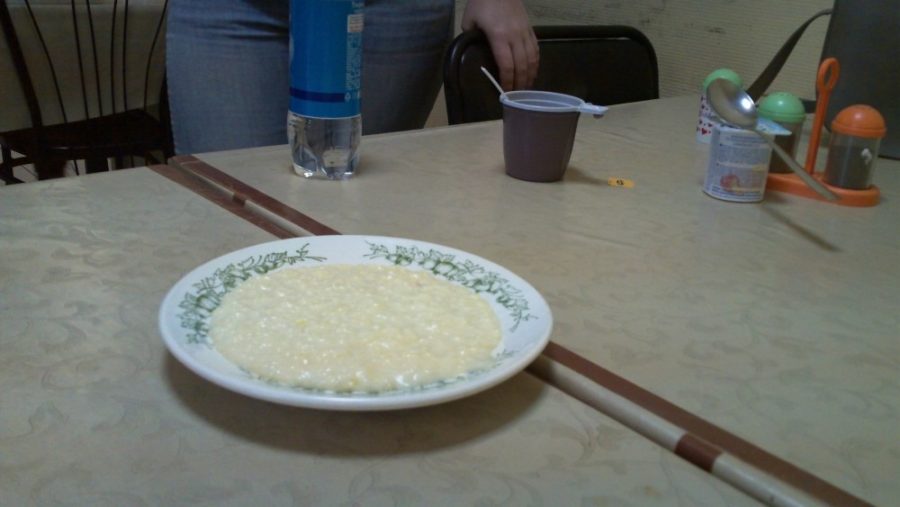Food and everything that surrounds it happens in a uniquely Russian way here in Russia. And that “Russian way” is different than a lot of us Americans expected.
Kasha makes up a pretty large part of our diet, so I’ll give it its due place here. Breakfasts at the university cafeteria always include kasha, which is a slightly-sweet or savory butter-heavy grain porridge.
Russians love it, and many eat it regularly. Per capita, Russians eat 33 pounds of it a year, which puts them at No. 1 in porridge consumption.
RELATED: Hello from Mother Russia
Porridge doesn’t seem to have any dismal connotation. In fact, in the two weeks I’ve been here, I’ve seen it mentioned three times in children’s TV shows (which I watch for listening comprehension): once in a list of “yummy foods,” once in a list of foods in everyone’s kitchen and once in a song about grocery shopping — in the line “I buy milk for kasha because kasha is good for kids.” It almost sounds like pro-kasha propaganda.
Most American students agree that kasha tastes pretty good, but many can’t get over the texture, and many can’t stomach eating the same thing for weeks straight.
As for me and a few others, we eat it happily every day. And that’s good for us. We have a wonderful lunch lady named Lyoba who we are convinced believes that if we don’t eat all of our kasha, we might die. She scouts out our lunch room to make sure we eat our kasha before anything else, and that we finish it. Otherwise, we get a hearty “ребенок,” (child).
When we think of foreign foods, we often think of a plethora of new dishes to try. Russians, though, seem pretty content without great variety. It’s a saying here that “kasha and shchi (cabbage soup) are our food.” I can agree that I’ve had both more than any other dish. It’s not a bad thing. In fact, it’s making me re-evaluate how much Americans crave constant variety.
Moscow is not how I pictured many European cities, with old, well-established restaurants and cafes. In many ways, Moscow is similar to my chain-heavy newly-developed hometown of Mesa, Arizona. I think that a lot of foreigners, including me, hoped to see something different than that, but we’ve had to become comfortable with Moscow’s context.
Although Moscow is an incredibly old city, it has had to re-invent itself after the fall of the Soviet Union and the subsequent collapse of the economy. Because of that, though, there are some leftover Soviet-style restaurants and stores scattered around the city.
The grocery stores where I live, outside of the city center, are quite underwhelming for Americans. The biggest supermarkets are about one-quarter the size of a standard Fry’s and don’t look as nice, either.
The stores perform their function as well as they need to, though, and don’t lack variety because of their size. Again, it’s made me question what I am used to in America. I’m so accustomed to seeing ten kinds of Cheerios and five knock-off brands in one giant cereal aisle. That’s kind of excessive. I’m beginning to see the elegance in the simplicity here.
The produce here doesn’t look as glamorous as in the United States either. Potatoes come with dirt and apples aren’t coated in wax. Carrots are often misshapen by our standards. Everything spoils a bit faster. But the produce tastes about the same, which for many things like tomatoes means tasteless.
RELATED: OPINION: President Robbins saves the day
However, it’s also easy to tasty berries and tomatoes at farmers markets here, which have thrived since the EU-US sanctions – but that’s another story.
There are some foods here that I have never seen in the United States. There are crab-flavored Lay’s (which actually taste like crab), popcorn chocolate (which is a chocolate bar with pieces of salty popcorn and pop rocks), tarragon soda, fried rye bread cut up like french fries, kephir (buttermilk to drink straight) and jams made from berries only found in Siberia.
By far my favorite cuisine here is Georgian. It includes kchacha puri, cheese breads, khinkali (dumplings), vegetable purees, liver and onion dishes and bean dishes. It is probably the spiciest cuisine we can find here. In this way, I think it reminds us Arizonans of Mexican food, which is absent, including anything resembling hot-sauce.
Probably most interesting for me is learning that many foods my mom made me when I was younger are traditional Russian dishes. I’m just in love with everything I try here because it feels so familiar, no matter how strange some of it is. I’ll probably be enjoying kasha until the day I leave, and miss it afterward.
Follow Daily Wildcat on Twitter









